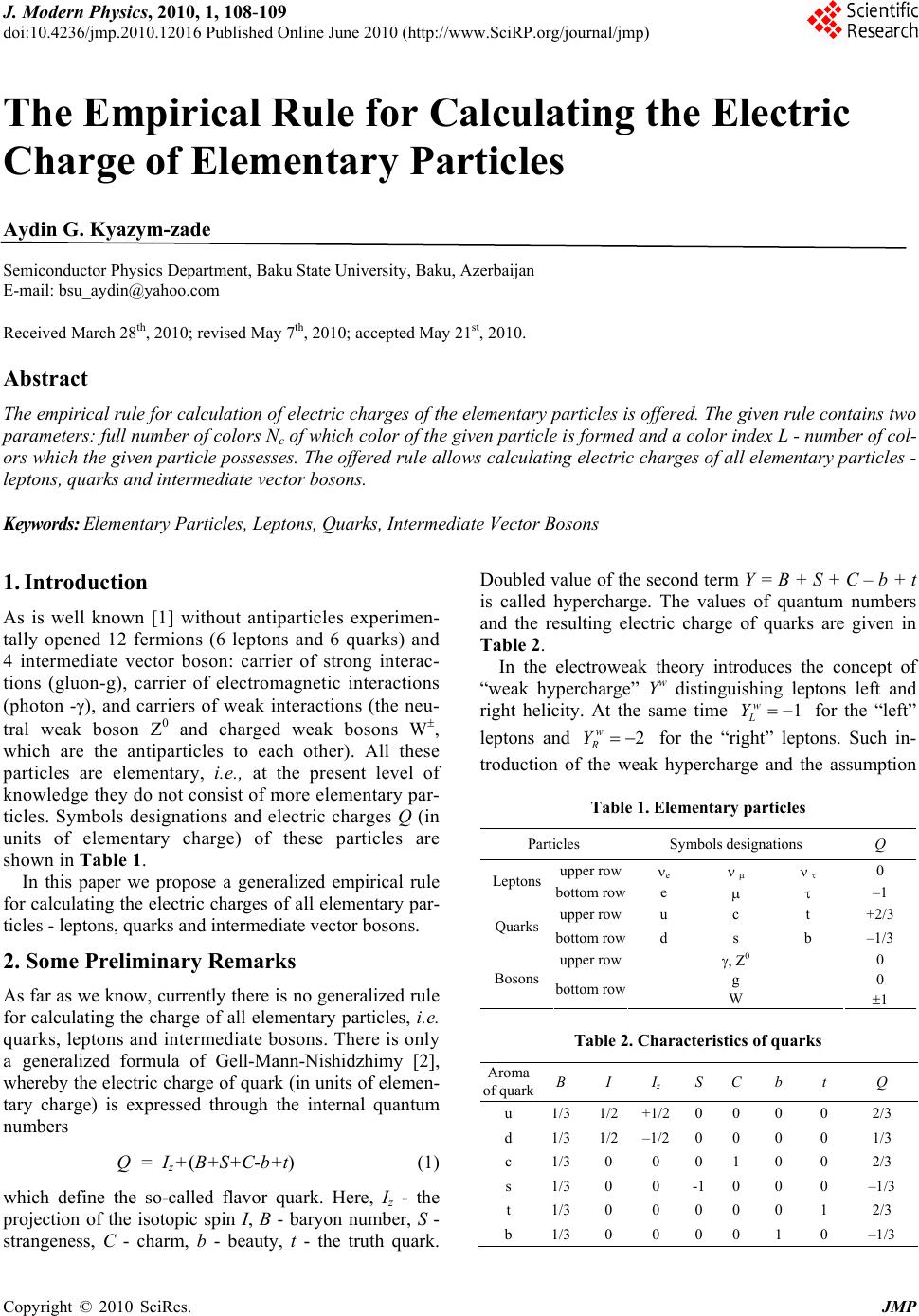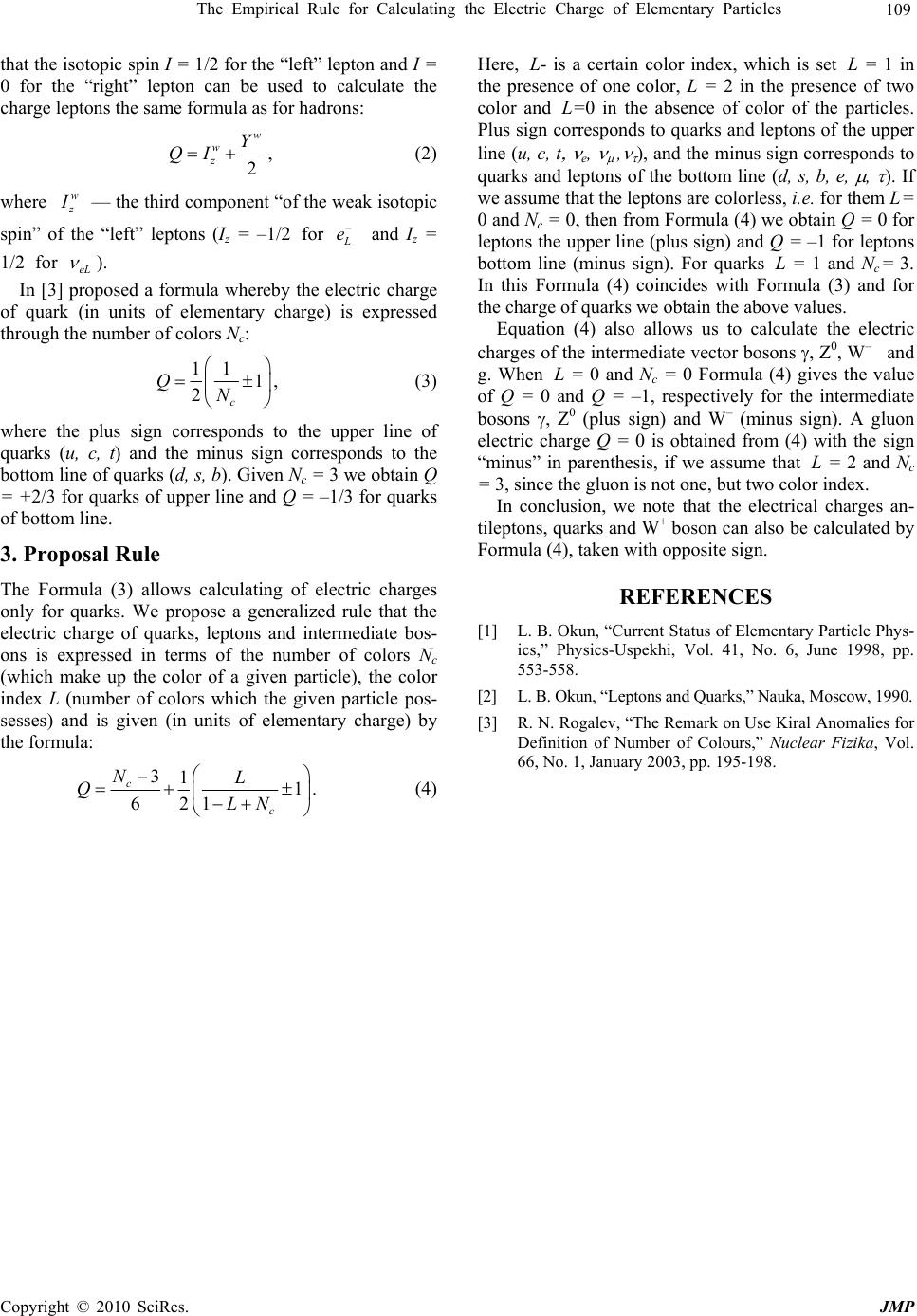Paper Menu >>
Journal Menu >>
 J. Modern Physics, 2010, 1, 108-109 doi:10.4236/jmp.2010.12016 Published Online June 2010 (http://www.SciRP.org/journal/jmp) Copyright © 2010 SciRes. JMP The Empirical Rule for Calculating the Electric Charge of Elementary Particles Aydin G. Kyazym-zade Semiconductor Physics Department, Baku State University, Baku, Azerbaijan E-mail: bsu_aydin@yahoo.com Received March 28th, 2010; revised May 7th, 2010; accepted May 21st, 2010. Abstract The empirical rule for calculation of electric charges of the elementary particles is offered. The given rule contains two parameters: full number of colors Nc of which color of the given particle is formed and a color index L - number of col- ors which the given particle possesses. The offered rule allows calculating electric charges of all elementary particles - leptons, quarks and intermediate vector bosons. Keywords: Elementary Particles, Leptons, Quarks, Intermediate Vector Bosons 1. Introduction As is well known [1] without antiparticles experimen- tally opened 12 fermions (6 leptons and 6 quarks) and 4 intermediate vector boson: carrier of strong interac- tions (gluon-g), carrier of electromagnetic interactions (photon -), and carriers of weak interactions (the neu- tral weak boson Z0 and charged weak bosons W, which are the antiparticles to each other). All these particles are elementary, i.e., at the present level of knowledge they do not consist of more elementary par- ticles. Symbols designations and electric charges Q (in units of elementary charge) of these particles are shown in Table 1. In this paper we propose a generalized empirical rule for calculating the electric charges of all elementary par- ticles - leptons, quarks and intermediate vector bosons. 2. Some Preliminary Remarks As far as we know, currently there is no generalized rule for calculating the charge of all elementary particles, i.e. quarks, leptons and intermediate bosons. There is only a generalized formula of Gell-Mann-Nishidzhimy [2], whereby the electric charge of quark (in units of elemen- tary charge) is expressed through the internal quantum numbers Q = Iz+(B+S+C-b+t) (1) which define the so-called flavor quark. Here, Iz - the projection of the isotopic spin I, B - baryon number, S - strangeness, C - charm, b - beauty, t - the truth quark. Doubled value of the second term Y = B + S + C – b + t is called hypercharge. The values of quantum numbers and the resulting electric charge of quarks are given in Table 2. In the electroweak theory introduces the concept of “weak hypercharge” Yw distinguishing leptons left and right helicity. At the same time 1 w L Y for the “left” leptons and 2 w R Y for the “right” leptons. Such in- troduction of the weak hypercharge and the assumption Table 1. Elementary particles Particles Symbols designations Q upper rowe 0 Leptons bottom rowe –1 upper rowu c t +2/3 Quarks bottom rowd s b –1/3 upper rowZ0 0 g 0 Bosons bottom rowW 1 Table 2. Characteristics of quarks Aroma of quarkB I Iz S Cb t Q u 1/31/2 +1/2 0 00 0 2/3 d 1/31/2 –1/2 0 00 0 1/3 c 1/3 0 0 0 10 0 2/3 s 1/3 0 0 -1 0 0 0 –1/3 t 1/3 0 0 0 00 1 2/3 b 1/3 0 0 0 01 0 –1/3  The Empirical Rule for Calculating the Electric Charge of Elementary Particles Copyright © 2010 SciRes. JMP 109 that the isotopic spin I = 1/2 for the “left” lepton and I = 0 for the “right” lepton can be used to calculate the charge leptons the same formula as for hadrons: 2 w w z Y QI , (2) where w z I — the third component “of the weak isotopic spin” of the “left” leptons (Iz = –1/2 for L e and Iz = 1/2 for eL ). In [3] proposed a formula whereby the electric charge of quark (in units of elementary charge) is expressed through the number of colors Nc: 11 1, 2c QN (3) where the plus sign corresponds to the upper line of quarks (u, c, t) and the minus sign corresponds to the bottom line of quarks (d, s, b). Given Nc = 3 we obtain Q = +2/3 for quarks of upper line and Q = –1/3 for quarks of bottom line. 3. Proposal Rule The Formula (3) allows calculating of electric charges only for quarks. We propose a generalized rule that the electric charge of quarks, leptons and intermediate bos- ons is expressed in terms of the number of colors Nc (which make up the color of a given particle), the color index L (number of colors which the given particle pos- sesses) and is given (in units of elementary charge) by the formula: 311. 621 c c NL QLN (4) Here, L- is a certain color index, which is set L = 1 in the presence of one color, L = 2 in the presence of two color and L=0 in the absence of color of the particles. Plus sign corresponds to quarks and leptons of the upper line (u, c, t e, , ), and the minus sign corresponds to quarks and leptons of the bottom line (d, s, b, e, , ). If we assume that the leptons are colorless, i.e. for them L= 0 and Nc = 0, then from Formula (4) we obtain Q = 0 for leptons the upper line (plus sign) and Q = –1 for leptons bottom line (minus sign). For quarks L = 1 and Nc = 3. In this Formula (4) coincides with Formula (3) and for the charge of quarks we obtain the above values. Equation (4) also allows us to calculate the electric charges of the intermediate vector bosons , Z0, W– and g. When L = 0 and Nc = 0 Formula (4) gives the value of Q = 0 and Q = –1, respectively for the intermediate bosons , Z0 (plus sign) and W– (minus sign). A gluon electric charge Q = 0 is obtained from (4) with the sign “minus” in parenthesis, if we assume that L = 2 and Nc = 3, since the gluon is not one, but two color index. In conclusion, we note that the electrical charges an- tileptons, quarks and W+ boson can also be calculated by Formula (4), taken with opposite sign. REFERENCES [1] L. B. Okun, “Current Status of Elementary Particle Phys- ics,” Physics-Uspekhi, Vol. 41, No. 6, June 1998, pp. 553-558. [2] L. B. Okun, “Leptons and Quarks,” Nauka, Moscow, 1990. [3] R. N. Rogalev, “The Remark on Use Kiral Anomalies for Definition of Number of Colours,” Nuclear Fizika, Vol. 66, No. 1, January 2003, pp. 195-198. |

